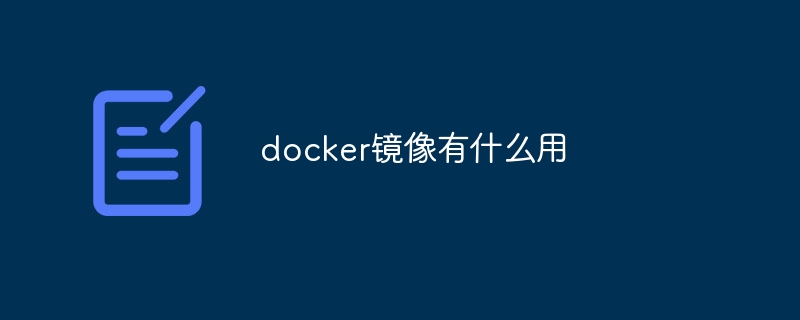What is the use of docker image?
Docker images are pre-built software components that can be used for a variety of purposes, including: Application deployment: Simplify deployment and improve portability. Software distribution: Provides software package visibility and control. Isolation and security: Isolate applications through a sandbox environment to improve security. Consistency: Ensure application behavior is consistent and reduce errors. Version Control: Allows tracking and rollback of application versions. Automation: Integrate with automation tools for seamless software processes.

Purpose of Docker Image
Docker image is a pre-built software component that contains everything needed to run an application Everything including code, libraries and dependencies. They can be used to deploy applications quickly and easily as it eliminates the need to manually set up software in different environments.
Docker images are used for a variety of purposes, including:
- Application Deployment: Docker images can be used to deploy applications without having to worry about the underlying infrastructure or Dependencies. This simplifies the deployment process and improves portability and repeatability.
- Software distribution: Docker images can be used to distribute software, such as microservices, tools, and libraries. This provides visibility and control over a package's contents and dependencies.
- Isolation and Security: Docker images provide isolation by running applications in a sandbox environment. This improves security and prevents conflicts and exploits between different applications.
- Consistency: Docker images ensure consistent application behavior in different environments. This helps reduce errors and simplifies troubleshooting.
- Version Control: Docker images are inherently versioned, which allows different versions of an application to be tracked and rolled back as needed.
- Automation: Docker images can be integrated with automation tools and pipelines for a seamless software development and deployment process.
By leveraging Docker images, development teams can accelerate application development and deployment, increase portability, and improve software quality and security.
The above is the detailed content of What is the use of docker image?. For more information, please follow other related articles on the PHP Chinese website!

Hot AI Tools

Undresser.AI Undress
AI-powered app for creating realistic nude photos

AI Clothes Remover
Online AI tool for removing clothes from photos.

Undress AI Tool
Undress images for free

Clothoff.io
AI clothes remover

Video Face Swap
Swap faces in any video effortlessly with our completely free AI face swap tool!

Hot Article

Hot Tools

Notepad++7.3.1
Easy-to-use and free code editor

SublimeText3 Chinese version
Chinese version, very easy to use

Zend Studio 13.0.1
Powerful PHP integrated development environment

Dreamweaver CS6
Visual web development tools

SublimeText3 Mac version
God-level code editing software (SublimeText3)

Hot Topics
 How to exit the container by docker
Apr 15, 2025 pm 12:15 PM
How to exit the container by docker
Apr 15, 2025 pm 12:15 PM
Four ways to exit Docker container: Use Ctrl D in the container terminal Enter exit command in the container terminal Use docker stop <container_name> Command Use docker kill <container_name> command in the host terminal (force exit)
 How to check the name of the docker container
Apr 15, 2025 pm 12:21 PM
How to check the name of the docker container
Apr 15, 2025 pm 12:21 PM
You can query the Docker container name by following the steps: List all containers (docker ps). Filter the container list (using the grep command). Gets the container name (located in the "NAMES" column).
 How to copy files in docker to outside
Apr 15, 2025 pm 12:12 PM
How to copy files in docker to outside
Apr 15, 2025 pm 12:12 PM
Methods for copying files to external hosts in Docker: Use the docker cp command: Execute docker cp [Options] <Container Path> <Host Path>. Using data volumes: Create a directory on the host, and use the -v parameter to mount the directory into the container when creating the container to achieve bidirectional file synchronization.
 How to restart docker
Apr 15, 2025 pm 12:06 PM
How to restart docker
Apr 15, 2025 pm 12:06 PM
How to restart the Docker container: get the container ID (docker ps); stop the container (docker stop <container_id>); start the container (docker start <container_id>); verify that the restart is successful (docker ps). Other methods: Docker Compose (docker-compose restart) or Docker API (see Docker documentation).
 How to start mysql by docker
Apr 15, 2025 pm 12:09 PM
How to start mysql by docker
Apr 15, 2025 pm 12:09 PM
The process of starting MySQL in Docker consists of the following steps: Pull the MySQL image to create and start the container, set the root user password, and map the port verification connection Create the database and the user grants all permissions to the database
 How to update the image of docker
Apr 15, 2025 pm 12:03 PM
How to update the image of docker
Apr 15, 2025 pm 12:03 PM
The steps to update a Docker image are as follows: Pull the latest image tag New image Delete the old image for a specific tag (optional) Restart the container (if needed)
 How to start containers by docker
Apr 15, 2025 pm 12:27 PM
How to start containers by docker
Apr 15, 2025 pm 12:27 PM
Docker container startup steps: Pull the container image: Run "docker pull [mirror name]". Create a container: Use "docker create [options] [mirror name] [commands and parameters]". Start the container: Execute "docker start [Container name or ID]". Check container status: Verify that the container is running with "docker ps".
 How to create containers for docker
Apr 15, 2025 pm 12:18 PM
How to create containers for docker
Apr 15, 2025 pm 12:18 PM
Create a container in Docker: 1. Pull the image: docker pull [mirror name] 2. Create a container: docker run [Options] [mirror name] [Command] 3. Start the container: docker start [Container name]






